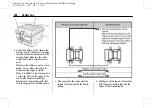
Chevrolet Low Cab Forward 6.7L Diesel Engine 6500XD (GMNA-Localizing-
U.S.-15749874) - 2022 - CRC - 12/2/21
234
Vehicle Care
overheat, which may result in property
damage and/or personal injury (see previous
WARNING).
Tires Used or Stored for a Long Period
of Time
Tires are a rubber product and degrade over
time, even if they are not being used. If any
of your tires is 5 to 7 years old or more,
please have them inspected for safe driving.
For further information, please check with
the tire manufacturer.
Dual Tire Operation
The outer tire of a pair on dual wheel
installations generally wears faster than the
inner tire. If this occurs, reverse the position
of the tires to equalize wear and get better
tire life.
In addition, when trucks are driven
continuously on high-crown roads, an
increase in air pressure of 35 kPa (5 psi) in
the outer tire of a dual tire operation will
prolong outer tire life. Be sure not to exceed
the inflation pressure limits shown on the
“
VIN, Weight Rating, and Greenhouse Gas
(GHG) Emissions Plate.
”
See
.
Wheel and Tire Balancing
Proper tire balancing provides the best
riding comfort and helps to reduce tire tread
wear. Out-of-balance tires can cause
annoying vehicle vibration and uneven tire
wear, such as cupping and flat spots. See
your authorized dealer for wheel balancing.
Front End Alignment
Proper front end alignment improves tire
tread mileage. Your vehicle's front end
suspension parts should be inspected often
and aligned when needed. (See the
Maintenance Schedule for more
information.) Improper alignment will not
cause the vehicle to vibrate; however,
improper toe-in alignment will cause front
tires to roll at an angle that will result in
faster tire wear. Incorrect caster or camber
alignment will cause your front tires to wear
unevenly, and may cause the vehicle to
"pull" to the left or right.
Tire Traction
A decrease in driving, cornering and braking
traction occurs when water, snow, ice, gravel
or other material is on the road surface.
Driving practices and vehicle speed should
be adjusted to the road conditions. When
driving on wet or slushy roads, it is possible
for a wedge of water to build up between
the tire and road surface. This is known as
hydroplaning, and may cause partial or
complete loss of traction, vehicle control and
stopping ability; this condition is also more
likely with worn tires.
To reduce the chance of traction loss, follow
these tips:
.
Slow down during rainstorms or when
roads are slushy.
.
Slow down if the road has standing water
or puddles.
.
Replace tires when front tread depth is
3.2 mm (4/32 in.) and rear tread depth is
1.6 mm (2/32 in.).
.
Keep tires properly inflated.




































